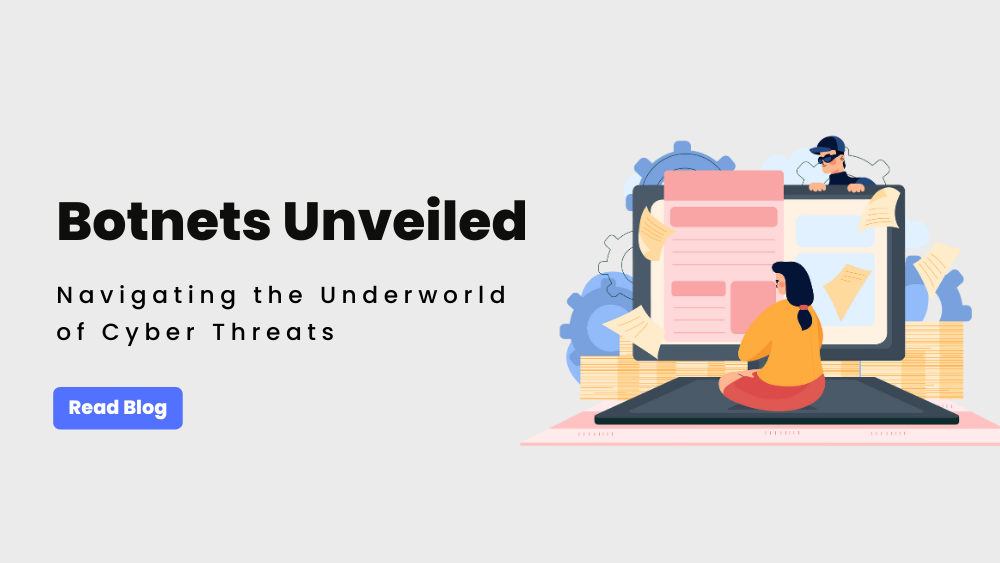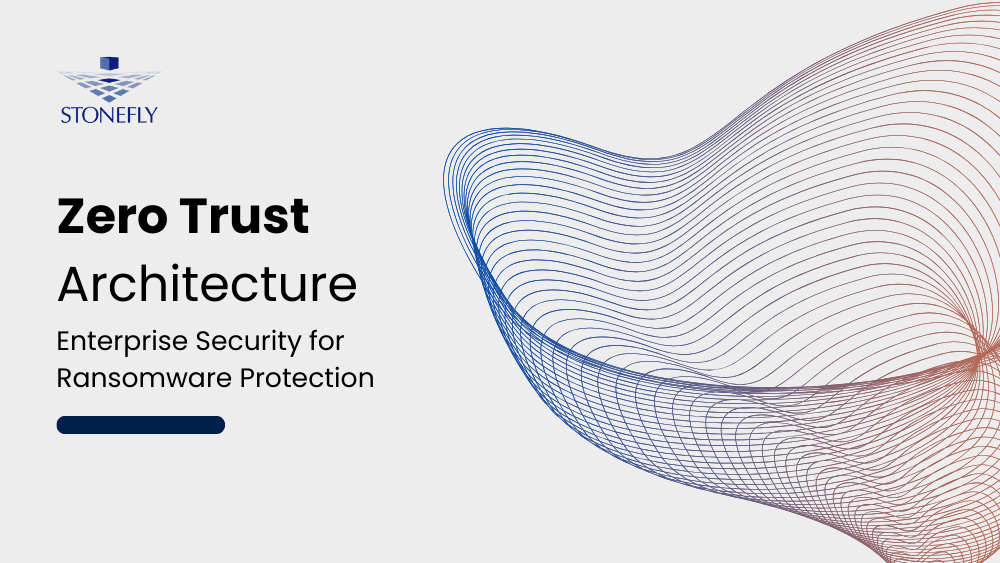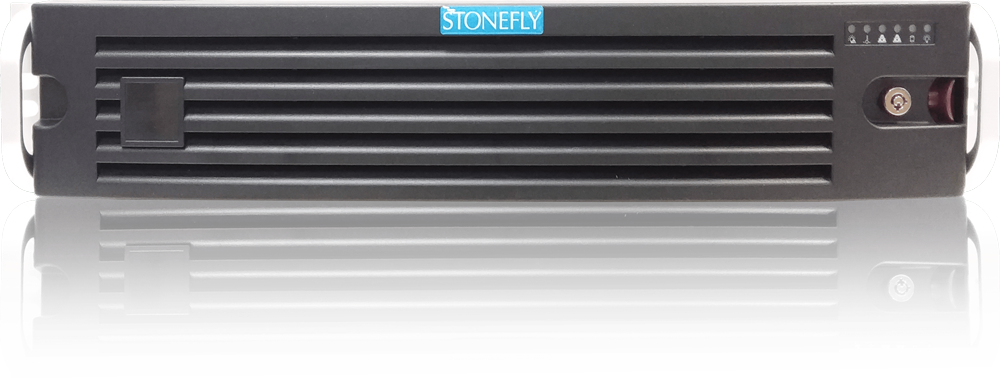In today’s interconnected digital landscape, where data is the lifeblood of businesses and individuals alike, cybersecurity has never been more critical. It’s a world where cyber threats loom large, and among them, botnets stand out as a particularly menacing adversary. In this blog, we embark on a journey to understand and confront the enigmatic realm of botnets, shedding light on their inner workings and the threats they pose to our digital existence.
What are botnets?
At its core, a botnet is a network of compromised computers, often referred to as “bots” or “zombies,” unwittingly under the control of a single malevolent entity. These compromised computers can range from personal laptops to entire data centers, and they are harnessed together, operating in unison like a silent army.
The cybercriminal orchestrating this army can remotely manipulate these compromised machines for various nefarious purposes, such as launching large-scale cyberattacks, distributing malware, or even stealing sensitive data. The sheer scale and anonymity afforded by botnets make them a formidable weapon in the hands of cybercriminals, and understanding their intricacies is paramount in defending against them.
Botnet Demystified: A Technical Deep Dive
This section delves into the inner workings, lifecycle, and intricate architectures of botnets with a focus on technical precision.
Inside the Botnet: A Deeper Dive
To fully comprehend botnets, it’s imperative to dissect their anatomy. At its core, a botnet comprises numerous compromised devices, referred to as “bots.” These bots are infected with malware, allowing cybercriminals to gain unauthorized control.
The control center, known as the Command and Control (C&C) server, acts as the puppeteer, orchestrating the actions of these compromised devices. This communication occurs through covert channels, making detection a challenge. Understanding the intricacies of bot communication protocols, encryption methods, and evasion techniques is vital for cybersecurity professionals aiming to thwart these threats effectively.
The Botnet Lifecycle: From Infiltration to Operation
Botnets, intricate as they are, closely mimic military strategies, adhering to a structured lifecycle that cybercriminals employ to wreak havoc on unsuspecting targets. This section dives into the technical intricacies of botnet lifecycles, illustrating their modus operandi and providing real-world examples for clarity.
Infiltration: The Initial Compromise
The lifecycle kicks off with the infiltration phase, where cybercriminals gain access to target devices. This stage can involve various techniques:
- Social Engineering Attacks: Cybercriminals exploit human psychology, often using deceptive emails, phishing campaigns, or malicious downloads to trick users into compromising their devices.
- Exploiting Vulnerabilities: Vulnerable software, unpatched systems, and known security weaknesses provide entry points. For instance, the infamous Conficker worm exploited a Windows vulnerability to propagate across networks.
The infamous “ILOVEYOU” worm in 2000 employed social engineering by enticing users to open a malicious email attachment, ultimately compromising millions of devices.
Command and Control (C&C): Orchestrating the Army
Once devices are compromised, they come under the control of the botnet’s command and control (C&C) server. This central server serves as the puppet master, issuing commands to the compromised devices and coordinating their actions.
The Mirai botnet used a centralized C&C structure to launch massive DDoS attacks. Its controllers could easily issue commands to thousands of infected IoT devices.
Execution: Carrying Out Malicious Activities
In the execution phase, botnets unleash their destructive potential. Activities at this stage vary widely and can include:
- Distributed Denial of Service (DDoS) Attacks: Botnets can flood target servers with traffic, overwhelming them and causing service disruptions. Notable examples include the Dyn attack in 2016 and the Mirai botnet’s role in it.
- Data Exfiltration: Some botnets are designed to steal sensitive data, which is then sent to the cybercriminals’ servers for exploitation or resale. The Zeus banking trojan is a prime example of a botnet involved in data theft.
- Malware Distribution: Botnets are often used as distribution networks for malware. Devices within the botnet may unwittingly propagate malware to other vulnerable systems.
The Emotet botnet was notorious for its data-stealing capabilities. It exfiltrated sensitive information from infected devices and was known to distribute other malware, such as TrickBot and Ryuk ransomware.
Diverse Botnet Architectures: Unmasking Their Complexity
Botnets exhibit remarkable diversity in their architectures, each tailored to suit specific purposes. While some adhere to a centralized Command and Control (C&C) structure, others employ decentralized Peer-to-Peer (P2P) networks. Internet of Things (IoT) botnets leverage vulnerable smart devices, and spam and malware distribution botnets facilitate large-scale malicious campaigns.
Understanding these varied architectures is fundamental to devising effective countermeasures. Cybersecurity experts must grasp the nuances, protocols, and communication methods unique to each botnet type, allowing them to develop precise strategies for detection, containment, and mitigation.
Botnet Categories: Different Types and Tactics
Botnets exhibit diverse architectures, each tailored for specific purposes. In this section, we explore various botnet categories, uncovering their unique characteristics, inner workings, and the cybersecurity threats they pose.
Command and Control (C&C) Botnets: Masters and Minions
C&C botnets exemplify centralized control. They rely on a central server or a cluster of servers to issue commands to the enslaved bots. These bots, distributed across compromised devices, dutifully execute the directives from their controllers.
Communication within C&C botnets is secured through encryption, rendering interception and decoding challenging. Rapid server updates and changes are common strategies for evading takedowns.
Peer-to-Peer (P2P) Botnets: Decentralized Threats
P2P botnets take a decentralized approach, allowing infected devices to communicate directly. The absence of a central server enhances their agility and resilience against takedown efforts.
P2P botnets leverage intricate overlay networks and dynamic communication methods among infected devices, evading detection while maintaining their distributed structure.
IoT Botnets: Hijacking the Internet of Things
IoT botnets target smart devices, exploiting vulnerabilities to turn them into unwilling participants. Their capability to compromise a wide array of IoT devices makes them a formidable threat.
IoT botnets commonly exploit security weaknesses in device firmware or rely on default credentials for infiltration, utilizing sophisticated methods for compromise.
Spam and Malware Distribution Botnets: The Underbelly of Cybercrime
Some botnets specialize in distributing spam emails or delivering malware payloads, facilitating large-scale malicious campaigns for cybercriminals.
To evade detection and spam filters, these botnets employ sophisticated tactics like email address spoofing and polymorphic malware, constantly adapting to stay one step ahead.
How to Detect Botnet Activity
Botnets can be elusive, but with the right techniques, their presence can be uncovered. In this section, we delve into advanced methods for detecting botnet activity, providing actionable steps to bolster your cybersecurity defenses.
Analyzing Network Traffic: Spotting the Red Flags
Botnets often exhibit distinctive patterns in network traffic, which can serve as red flags. To detect these anomalies:
Step 1: Implement Deep Packet Inspection (DPI)
Deep Packet Inspection (DPI) tools allow you to scrutinize network packets thoroughly, giving you a granular view of the data traversing your network. To detect botnet activity:
- Select a DPI Solution: Choose a DPI tool that suits your network infrastructure and requirements. There are both open-source and commercial DPI solutions available.
- Configure DPI for Traffic Analysis: Set up your DPI tool to analyze inbound and outbound network traffic. Specify the network interfaces and traffic types to monitor.
- Identify Unusual Traffic Patterns: Define what constitutes normal traffic patterns for your network. This might include typical data transfer rates, communication protocols, and ports in use.
- Create DPI Rules: Craft DPI rules that flag unusual traffic patterns. For example, you might create rules that trigger alerts for high-volume outbound connections or unexpected communication between devices.
- Monitor DPI Alerts: Continuously monitor DPI alerts generated by your tool. Investigate any alerts promptly to determine if they indicate botnet activity.
Step 2: Employ Flow Analysis Tools
Flow analysis tools are invaluable for tracking the flow of data across your network. To detect botnet activity using flow analysis:
- Select a Flow Analysis Solution: Choose a flow analysis tool that aligns with your network size and complexity. Ensure it supports flow collection and analysis.
- Configure Flow Analysis Parameters: Configure the tool to collect flow data from network devices, such as routers and switches. Specify which network segments to monitor.
- Establish Baselines: Establish behavioral baselines for your network traffic. These baselines represent the typical patterns of traffic during different times of day and days of the week.
- Set Thresholds for Anomalies: Define thresholds that trigger alerts when deviations from the baselines occur. For instance, you might set a threshold for data transfer rates or the number of connections.
- Regularly Review Flow Data: Regularly review flow data and investigate any anomalies that breach the defined thresholds. Look for sudden spikes in data transfers or unexpected connections.
Step 3: Establish Behavioral Baselines
Establishing behavioral baselines for your network is crucial for detecting deviations that might indicate botnet infiltration. Follow these steps:
- Collect Historical Data: Gather historical network traffic data for different times of day and days of the week. This data will serve as the basis for creating baselines.
- Analyze Normal Traffic Patterns: Examine the historical data to identify normal traffic patterns. Consider factors like data volume, communication patterns, and resource utilization.
- Create Behavioral Baselines: Using the insights gained from the analysis, create behavioral baselines for different network segments and times. These baselines should represent expected behavior.
- Define Deviation Thresholds: Set thresholds that trigger alerts when network activity deviates significantly from the established baselines. Ensure these thresholds are well-calibrated to minimize false positives.
- Automate Baseline Monitoring: Implement automated monitoring tools that continuously compare current network behavior to the established baselines. Configure alerts to trigger when deviations occur.
Anomaly Detection: Unusual Behavior Under Scrutiny
Anomalies in system behavior can be indicative of botnet activity. Here’s how to leverage this approach:
Step 1: Implement User and Entity Behavior Analytics (UEBA)
User and Entity Behavior Analytics (UEBA) solutions are invaluable for monitoring user and entity activities. To detect botnet activity using UEBA:
- Select a UEBA Solution: Choose a UEBA solution that aligns with your organization’s size and complexity. Ensure it supports a wide range of data sources for comprehensive monitoring.
- Integrate Data Sources: Integrate various data sources, including logs from authentication systems, network devices, and user activity logs. This holistic approach provides a comprehensive view of user behavior.
- Define Normal Behavior Profiles: Establish profiles of normal behavior for users and entities within your organization. Consider factors such as login patterns, access privileges, and typical working hours.
- Analyze Behavior Patterns: Continuously analyze user and entity behavior patterns against the established profiles. UEBA solutions can identify deviations, such as unusual login times, repeated failed login attempts, or access to unauthorized resources.
- Set Alert Thresholds: Configure alert thresholds that trigger notifications when behavior anomalies exceed predefined limits. Fine-tune these thresholds to minimize false positives while ensuring the detection of genuine threats.
Step 2: Employ Endpoint Anomaly Detection
Endpoint security solutions that analyze device behavior play a crucial role in detecting botnet activity. Follow these steps to implement endpoint anomaly detection:
- Choose an Endpoint Security Solution: Select an endpoint security solution that provides behavior analysis capabilities. Ensure it supports a wide range of devices, including desktops, laptops, and mobile devices.
- Install and Configure Agents: Deploy security agents on your organization’s endpoints, including computers and mobile devices. Configure these agents to collect and transmit behavioral data.
- Baseline Device Behavior: Establish baselines for normal device behavior. This includes factors like CPU and memory utilization, application usage, network connections, and file access.
- Continuous Monitoring: Enable continuous monitoring of endpoint behavior. The security solution should analyze data collected by agents in real-time to identify any deviations from the established baselines.
- Alert on Suspicious Activity: Configure the security solution to generate alerts and notifications when it detects suspicious activity. These may include resource-intensive processes, unauthorized access attempts, or unusual network communication.
Step 3: Utilize Network-Based Anomaly Detection (NBAD)
Network-Based Anomaly Detection (NBAD) systems are crucial for assessing network traffic for unusual activities. To effectively implement NBAD for botnet detection:
- Select an NBAD Solution: Choose an NBAD solution that can analyze network traffic across your organization’s network segments. Ensure it supports deep packet inspection and traffic analysis.
- Define Normal Network Behavior: Establish a baseline for normal network behavior by analyzing historical network traffic data. Consider factors like data transfer rates, communication patterns, and peak traffic times.
- Configure Traffic Analysis: Configure the NBAD system to monitor inbound and outbound network traffic continuously. It should inspect packets for anomalies and deviations from the established baseline.
- Set Alert Thresholds: Define alert thresholds that trigger notifications when the NBAD system detects deviations from normal network behavior. Customize these thresholds to minimize false positives.
- Review and Investigate Alerts: Regularly review alerts generated by the NBAD system. Investigate any alerts promptly to determine if they indicate potential botnet activity.
Signature-Based Detection: Identifying Known Threats
Signature-based detection relies on predefined patterns or signatures of known threats. To effectively employ this technique:
Step 1: Utilize Antivirus and Anti-Malware Solutions
Antivirus and anti-malware solutions are essential components of your botnet detection strategy, as they rely on predefined patterns or signatures of known threats. To effectively employ this technique:
- Select Comprehensive Security Software: Choose robust antivirus and anti-malware software that includes extensive signature databases. These databases contain patterns of known botnet threats.
- Install and Update Regularly: Install the selected security software on all endpoints within your organization. Ensure it’s set to automatically update its signature database regularly to stay current.
- Configure Real-Time Scanning: Enable real-time scanning on all devices to monitor file downloads, email attachments, and web traffic for known botnet signatures.
- Schedule Full System Scans: Set up regular full system scans to check for botnet infections that may have evaded real-time scanning. These scans thoroughly inspect all files and directories.
- Quarantine and Remediate: Configure the software to automatically quarantine or isolate any files or processes that match known botnet signatures. Implement remediation steps to remove or repair affected files.
Step 2: Implement Intrusion Detection Systems (IDS)
Intrusion Detection Systems (IDS) play a crucial role in identifying known botnet signatures within network traffic. To effectively employ this technique:
- Choose an IDS Solution: Select an IDS solution suitable for your organization’s network architecture. It should support deep packet inspection and signature-based detection.
- Install IDS Sensors: Deploy IDS sensors strategically within your network to monitor traffic at critical points, such as network ingress and egress points, and between network segments.
- Define Signature-Based Rules: Configure the IDS to use signature-based rules that match known botnet signatures. These rules identify patterns, behaviors, or characteristics specific to botnet activity.
- Set Alert Priorities: Assign different alert priorities to different types of botnet signatures. For example, prioritize alerts for signatures associated with highly malicious botnet activities like DDoS attacks.
- Log and Investigate Alerts: Ensure that the IDS logs all alerts generated by signature matches. Investigate alerts promptly to determine the scope and impact of detected botnet activity.
- Implement Automated Responses: Consider implementing automated response actions, such as blocking malicious IP addresses or isolating affected network segments, to contain botnet threats.
Behavior-Based Detection: Monitoring for Aberrations
Botnets often exhibit specific behavioral patterns. To identify these aberrations:
Step 1: Implement Heuristic Analysis
Heuristic analysis tools are invaluable for identifying botnet-related behavioral aberrations that may not match known signatures. To effectively employ this technique:
- Select a Heuristic Analysis Tool: Choose a heuristic analysis tool that can monitor and identify suspicious behaviors, even if they don’t align with known botnet signatures.
- Deploy the Tool Across the Network: Deploy the selected tool across your organization’s network, including endpoints, servers, and network infrastructure. Ensure it has access to relevant data sources.
- Configure Behavior Baselines: Establish behavior baselines for various entities within your network, such as devices, users, and applications. These baselines represent expected behavior.
- Monitor for Anomalies: Continuously monitor network and endpoint behavior for anomalies that deviate from the established baselines. Look for unusual communication patterns, resource utilization, or access requests.
- Customize Alerting: Configure the tool to generate alerts and notifications when suspicious behavior is detected. Customize alert thresholds based on the severity of deviations.
Step 2: Leverage Machine Learning Models
Machine learning models are powerful tools for analyzing network and endpoint behavior to detect subtle deviations. To effectively employ this technique:
- Choose Machine Learning Algorithms: Select machine learning algorithms suitable for analyzing network and endpoint behavior. Common algorithms include anomaly detection and clustering.
- Collect Training Data: Gather a diverse dataset of network and endpoint behavior data for training the machine learning model. This dataset should include normal and abnormal behavior examples.
- Train the Model: Use the collected dataset to train the machine learning model. The model will learn to identify patterns and behaviors associated with botnet activity.
- Implement Real-Time Analysis: Integrate the trained machine learning model into your network and endpoint security infrastructure. Ensure it can perform real-time analysis of behavior.
- Customize Alerting and Response: Configure the model to generate alerts when it identifies behavior that deviates significantly from normal patterns. Additionally, set up automated response actions, such as isolating affected devices or blocking malicious traffic.
- Continuous Monitoring and Retraining: Continuously monitor the performance of the machine learning model. Periodically retrain the model with updated data to adapt to evolving botnet tactics.
For AI-integrated network log analysis, check out StoneFly AI LogPro X1.
How to Mitigate Botnet Risks
Mitigating botnet risks is crucial to safeguarding your organization’s data and operations. In this section, we explore comprehensive strategies and actions to fortify your cybersecurity defenses against botnet threats.
Fortifying Network Security
Network security forms the foundation of your botnet risk mitigation efforts. Strengthen your network defenses with these measures:
- Firewall Fortifications: Building Strong Barriers
- Implement Next-Generation Firewalls: Upgrade to next-generation firewalls (NGFWs) equipped with advanced threat detection capabilities. Configure them to inspect both inbound and outbound traffic for botnet-related activities.
- Segment Your Network: Divide your network into segments based on security requirements. Use firewalls to enforce strict access controls between segments, limiting lateral movement for potential botnet infections.
- Air-Gap Critical Systems: For added protection, air-gap critical systems from the main network. Air-gapping physically isolates these systems, making it extremely difficult for botnets to infiltrate.
- Intrusion Detection and Prevention: Keeping Watch
- Deploy Intrusion Detection Systems (IDS) and Intrusion Prevention Systems (IPS): IDS and IPS solutions continuously monitor network traffic for suspicious activities. They can detect and block botnet-related intrusion attempts in real-time.
- Utilize Anomaly-Based Detection: Configure IDS/IPS to use anomaly-based detection to identify deviations from normal network behavior. This can help detect botnet activity that may not match known signatures.
Enhancing Endpoint Security
Protecting endpoints is paramount in mitigating botnet risks. Strengthen your endpoint defenses with these measures:
- Antivirus and Antimalware: Warding off Infections
- Deploy Advanced Antivirus Solutions: Choose antivirus and antimalware solutions that offer real-time scanning and behavioral analysis. Keep them updated to identify the latest botnet threats.
- Implement Endpoint Air-Gapping: Apply air-gapping to sensitive endpoints, such as servers and critical workstations. This isolation prevents direct access to these systems, even if other endpoints are compromised.
- Host-Based Intrusion Detection: Alerts from Within
- Implement Host-Based Intrusion Detection Systems (HIDS): HIDS solutions provide granular visibility into the behavior of individual endpoints. They can identify unauthorized access attempts and abnormal system activities often associated with botnet infiltration.
- Enable Endpoint Sandboxing: Some HIDS solutions offer endpoint sandboxing capabilities. Sandboxing allows the execution of potentially malicious files in a controlled environment, protecting the endpoint from infection.
- Proactive Cyber Hygiene: Patching and Updating
- Regularly Patch and Update: Maintain a proactive approach to patch management. Regularly apply security updates and patches to both operating systems and software applications to eliminate vulnerabilities that botnets exploit.
- Immutable Backup Solutions: Leverage backup and disaster recovery solutions with immutability features. Immutability ensures that backup data remains unchanged and unmodifiable, even if a botnet compromises primary systems.
How to Prepare for Botnet Attacks
Preparation is key to effectively countering botnet attacks. In this section, we outline essential steps to fortify your organization’s defenses and readiness in the face of botnet threats.
Step 1: Building Resilience – Crafting an Incident Response Plan
An incident response plan (IRP) is your playbook for addressing botnet attacks and minimizing their impact. Develop a robust IRP with the following key elements:
- Incident Classification: Define categories of botnet-related incidents, from minor infections to major breaches, and establish response procedures tailored to each.
- Incident Response Team: Assemble a dedicated incident response team comprising IT professionals, cybersecurity experts, legal counsel, and communication specialists.
- Communication Protocols: Establish clear communication channels and procedures for notifying stakeholders, including employees, customers, and regulatory authorities.
- Containment and Eradication: Outline steps to contain botnet incidents swiftly and eradicate botnet presence from affected systems.
Step 2: Strengthening Access Controls – Guarding the Entry Points
Effective access controls reduce the likelihood of botnet infiltrations. Implement access control measures as follows:
- Multi-Factor Authentication (MFA): Enforce MFA for user access to sensitive systems, making it significantly harder for botnets to compromise accounts.
- Privileged Access Management (PAM): Implement PAM solutions to tightly control and monitor privileged user access, reducing the risk of insider threats.
- Network Segmentation: Further segment your network, ensuring that only authorized users and devices can access specific network segments. This hampers lateral botnet movement.
Step 3: Data Resilience – Strategies for Backup and Recovery
Data resilience is critical for maintaining operations during and after a botnet attack. Strengthen your data resilience with the following strategies:
- Regular Backups: Implement a robust backup strategy that includes regular backups of critical data and systems.
- Air-Gapped Backups: Create air-gapped backups stored securely offline to prevent botnets from compromising them.
- Immutable Backups: Utilize backup solutions with immutability features, preventing botnets from altering or deleting backup data.
- Offsite Storage: Store backups offsite to ensure data availability even if the primary network is compromised.
- Testing and Validation: Regularly test and validate your backup and recovery processes to ensure their effectiveness in botnet recovery scenarios.
Step 4: Continuous Vigilance – Monitoring and Auditing Network Traffic
Constant monitoring and auditing of network traffic helps detect botnet activity early. Follow these practices:
- Network Traffic Analysis: Employ network traffic analysis tools to scrutinize incoming and outgoing traffic patterns for signs of botnet activity.
- Anomaly Detection: Implement anomaly detection solutions that can identify deviations from normal network behavior, triggering alerts when botnet-like activities occur.
- Regular Auditing: Conduct regular audits of network traffic, user activities, and system logs to identify and investigate any unusual behavior or security incidents.
- Sandbox Environments: Deploy sandbox environments for advanced threat analysis, isolating suspicious files or activities for in-depth examination.
- Log Analysis: Leverage AI-integrated log analysis tools to sift through vast datasets, pinpointing potential botnet-related anomalies in logs.
For advanced log analysis, consider our AI-integrated log analysis appliance, and for sandbox environments, explore our AI-Integrated sandbox appliance for comprehensive threat mitigation.
Conclusion
In the ever-evolving landscape of cybersecurity, botnets continue to pose a persistent threat. Armed with knowledge and a proactive stance, organizations can navigate this perilous terrain more effectively. By understanding botnet intricacies, implementing vigilant detection measures, and fortifying defenses, you bolster your readiness to counter these threats.










